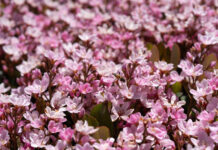
During the Oct. 31 UCR Bell Tower Nooner, a procession of thundering drums and painted skull faces danced toward the Bell Tower. In their rainbow colored tunics, the dancers blessed the campus and honored their past relatives at the various altars across campus. Laid out across a black cloth were scented candles and various butterfly cutouts — red, striped, blue, green. The aroma of conchas permeates through the air, and in the center, a framed picture of a past relative forms a gateway for the dead to traverse from the land of the dead to the land of the living.
Chicano Student Programs (CSP) have celebrated Dia de Los Muertos annually since 1972. The event is held at the Bell Tower, where CSP-affiliated organizations each build their own altar to honor those that have passed. Students of UCR as well as those from various local schools lined up to join in on the festivities, including face painting and sugar skull decorating.
Dia de los Muertos — Day of the Dead — is a special day for the Latino community, as it symbolizes the day of remembrance when past relatives can cross the barrier from the afterlife to the living and be with present family members. Items that the late relatives enjoyed are offered to express remembrance and admiration for the relatives. Owner of Sweet Angel Creations, who sold tamarindo apples and sugar cookies throughout the event, Maria Hernandez, says that “Dia de los Muertos is a celebration of life of the people that have left. We invite them to come back and we have offerings for them of their favorite things — things that they liked to do or food that they enjoyed eating.” Moreover, Dia de los Muertos is an opportunity for Latinos to reclaim their identity on American soil, given the current political climate. Hernandez explains, “sometimes when you move away from home or not close by, it’s harder to do things that celebrate your culture or bring others. And it shows other students from other cultures, that this is what it is. The Mexican tradition of embroidered vestidos bordados, horchata, Frida Kahlo, etc.” The celebration on campus is an opportunity for Hernandez to “bring (her) flavors (and) cultures into (her) creations.”
Moreover, Dia de los Muertos gives representation to Latino individuals. Victor Hugo Marroquin, a fourth-year philosophy and gender and sexualities major, remarks “It’s a day of remembrance. Even though it comes with the pain of remembering the dead, death is rebirth; it’s the next journey for the ones that are no longer presente.” To Marroquin, it’s important that UCR honors their lives and ancestral lineage. Marroquin reflects, “As Chicanx, we come from a place of resistance, and we can’t forget where we came from.”
Dia de Los Muertos often represents an opportunity for Latinos around the world to reclaim pride in their identity. Marroquin recalls, “I wanted to be white. I didn’t like the color of my skin, and so it took a lot for us to be here with our individual stories. We stand together — people from our community — with shared experiences … we are marginalized and this event makes me feel strong.”
Melissa Vega, a second-year sociology major, does Aztec dancing back home, but notes it doesn’t feel the same without a community with individual struggles and stories. Vega comments, “Whether you believe spirits are real, Dia de los Muertos is a day of remembering the values of the ancestors that are instilled in your family for generations. Keep in mind that we are descendents of immigrants and we resonate with their personal struggles of the trek.” Also, Dia de Los Muertos is something Latinos do everyday; they have altars in their houses to honor the dead.
Akatzin Torrez, a second-year linguistics and Spanish major, reflected on all the face painted skulls, explaining, “It’s our way of honoring the idea of muerte and Catrina, the female version of death. The long dress and dances and honors symbolizes that we all eventually reach death, but we should embrace it.”
Dia de los Muertos is a holiday that teaches those who participate to not fear death but to welcome it. CSP hopes to continue to honor these traditions with their future events.







